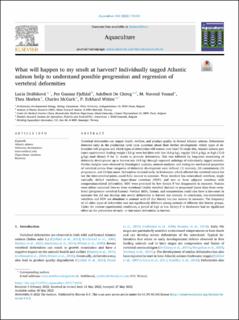| dc.description.abstract | Vertebral deformities can impair health, welfare, and product quality in farmed Atlantic salmon. Deformities detected early in the production cycle raise questions about their further development: which types of deformities will progress and which types of deformities will worsen over time? To study this, Atlantic salmon parr (start experimental feeding weight 13.5 g) were fed diets with low (6.8 g/kg), regular (10.0 g/kg), or high (13.0 g/kg) total dietary P for 11 weeks to provoke deformities. This was followed by long-term monitoring of deformity development up to harvest size (4.5 kg) through repeated radiology of individually tagged animals. Further insights were obtained by histological analyses, mineral analyses, and testing for mechanical properties of vertebral centra. Four categories of deformity development were defined: (1) recovery, (2) containment, (3) progression, and (4) late-onset. Deformities detected early, in freshwater, which affected the vertebral centra but not the intervertebral joints, could fully recover in seawater. These involved low-mineralised vertebrae, single vertically shifted vertebrae, hyper-dense vertebrae (HDV), and two or three adjacent vertebrae with compression-related deformities. HDV were provoked by low dietary P but disappeared in seawater. Fusions were either contained (two to three vertebrae) (stable vertebral fusions) or progressed (more than three vertebrae) (progressive vertebral fusions). Vertical shifts, fusions, and compressions could also have a late-onset in seawater but did not develop into severe deformities in harvest size animals. In conclusion, low-mineralised vertebrae and HDV are abundant in animals with LP diet history but can recover in seawater. The frequency of all other types of deformities was not significantly different among animals of different diet history groups. Under the current experimental conditions, a period of high or low dietary P in freshwater had no significant effect on the prevalence of early- or late-onset deformities at harvest. | en_US |
